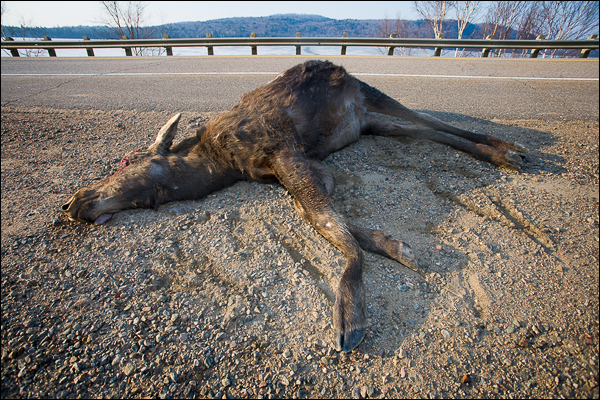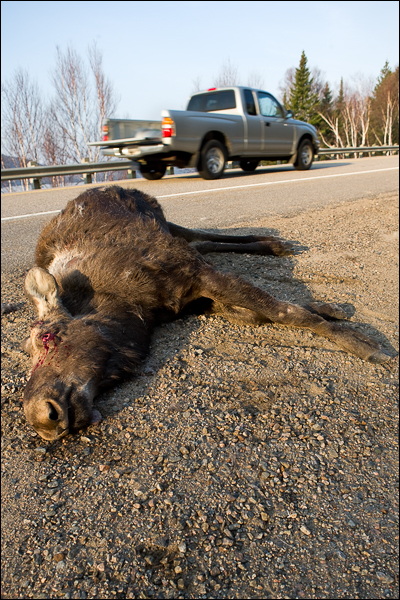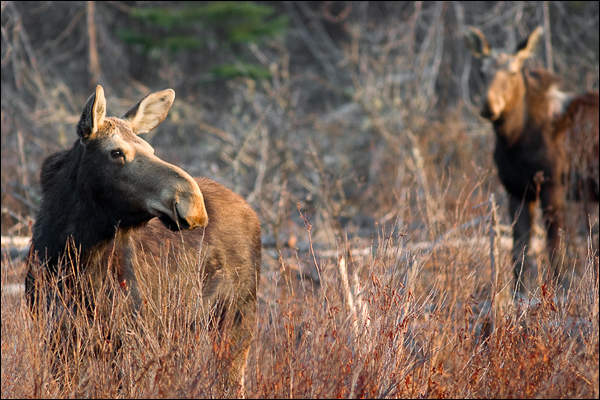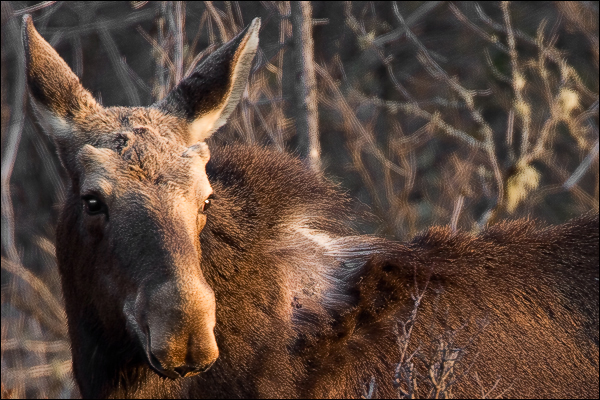A road’s impact on wildlife in Ontario
I remember reading a research paper on a female moose (cow) traveling a fairly long distance between Adirondacks in US to Algonquin Park in Ontario Canada. Usually the male moose (bull) travels large distances, but in this case the female decided on the long and perilous trip, which included swimming across the St. Lawrence River and crossing the highly trafficked 401 highway. She traveled over 300 kilometers to her last destination – Algonquin Park. A year later, her remains were found via the attached radio collar. Cause of death unknown.
As I was reading the paper I remember reflecting on how strong these animals are, yet their life is so fragile – such a loss after such a daring effort. Same thoughts came about when encountering this moose cow.

Female Moose Killed On Highway 60 in Algonquin Park
The accident must have just happened, as driving through the same stretch of road just a half hour earlier didn't produce any moose, dead or alive. The 600-700 pounds female was struck and thrown violently to the side of the road with her legs broken and twisted by the force of the impact. There’s not much you can do in this situation other than hope she died instantly. There was no car around when I found her and seeing how she was simply tossed aside during the impact I can only assume the female moose was struck by a large truck.
Just as I was parking my car to photograph her, the park staff was advising on the radio to avoid possibly deadly accidents by driving carefully on the highway, as moose approach and cross the road frequently during springtime. I’m told two dozen moose are killed each year in Algonquin Park on Highway 60 as a result of vehicular accidents. I wonder why we let this happen in the oldest and most famous provincial park in Ontario. Highway 60 just claimed another victim and the young moose is now just another statistic.

Female Moose Killed In Vehicular Accident
Many times I questioned the need of logging in Algonquin Park. It seems Algonquin is currently the only provincial park in Canada allowing tree harvesting. Besides the environmental impact of cutting trees (read about old-growth forest in Algonquin Park at the end of the story), there is also the aspect of the huge logging trucks traveling at high speeds on the only highway traversing the park. The same highway used by thousands of locals and tourists each month and with frequent wildlife crossings.
Finding the moose
Leaving the unfortunate moose, I continued cruising back and forth between km 15 and 50 in search for other ones to photograph. Hopefully moose that are alive and well. A few times I caught their shadows moving through the woods but I had to keep searching as the shooting conditions were not acceptable. Either the moose was deep into the forest or thick bushes were blocking my view.
Another half hour of driving and here they were. Lady luck was on my side after all. Just near the road a female moose with her calf were browsing a small clearing for food and water.

Female Keeping a Close Watch Over Her Calf in Early Morning Light
In this case, all conditions have been met for me to set camp: they stopped for a drink in a fairly open space, and they were positioned on the north side of the road thus directly engulfed by the warmth of the morning light. I couldn't ask for more. I parked and for the next few minutes I enjoyed watching and photographing the Algonquin moose.
Moose and the winter tick parasite
An interesting aspect I noted as I was shooting for this story was the patches of missing fur on their bodies. These patches are the indirect result of the winter tick parasite that affects moose in great numbers. The Algonquin Wildlife: Lessons in Survival
 by Dan Strickland describes in more detail how moose in Algonquin is affected by the winter tick. These ticks stay in the vegetation and wait for the unaware moose. As the moose passes through the vegetation, the tick attaches itself to the skin and starts feeding on the victim’s blood. As they become infested with thousands of ticks, the moose starts scratching persistently against trees and rocks until large quantities of hair are lost. By loosing hair they lose the ability to protect themselves from the bitter cold of the winter and thus many perish.
by Dan Strickland describes in more detail how moose in Algonquin is affected by the winter tick. These ticks stay in the vegetation and wait for the unaware moose. As the moose passes through the vegetation, the tick attaches itself to the skin and starts feeding on the victim’s blood. As they become infested with thousands of ticks, the moose starts scratching persistently against trees and rocks until large quantities of hair are lost. By loosing hair they lose the ability to protect themselves from the bitter cold of the winter and thus many perish.

Moose Calf with Missing Fur Due to Winter Tick Parasite
The video behind this story starts with the female moose and her calf investigating myself and the rest of the cars that continued pulling over behind mine. She spent a few minutes making sure that we are not a threat to herself and her calf. Cows have strong maternal instincts. Besides protecting their calves, the female will assume the parenting role seriously and teach their young all aspects of life, including walking, hiding, swimming and even feeding on submerged plants. She then continues towards the pool of melted snow along the side of the highway. As she satisfies her thirst, she crosses the highway just behind the cars, now all stopped on the other side of the road. Luckily, this time, no truck approached this stretch of highway.
Technical Notes: Filmed in HDV 1080i format
Tips on photographing the moose
Springtime is a very good time for spotting these magnificent animals as they come for the dissolved salt runoff along the highway 60. As the winter recedes and the snow melts, salt is deposited on the side of the road and one can easily experience moose drinking from the water pools to replenish their minerals. Here are a few tips to ensure a safe and inspiring moose encounter on Algonquin’s Highway 60:
- Be on location early or late in the day. At times you may find them throughout the day as well, but my travel through this park was always productive either very early in the morning or late afternoon. If you come to photograph, plan your driving on the highway with the sun behind you. You’ll have better light and vehicles driving in the same direction with you will have better visibility.
- Park your car safely on the side of the road. Don’t just slow down your car to watch. There is a fair amount of traffic on the highway and some of those vehicles are logging trucks traveling at speeds of 80KM +. Plus, the road is winding through the hills and vegetation and visibility at a distance may be poor at times.
- Allow space between your car and the moose. Although they seem used to vehicles it’s a good practice to give them a bit of space. I always use the car as a blind and photograph or film through the car window or from behind the car. Moose is more used to cars than humans. See the video to witness the cow crossing the highway just a few meters away from the parked cars.
- Turn your car engine off. It’s less disturbance and you eliminate camera vibrations when photographing. Also, you reduce pollution and you are not intoxicating other cars that most likely will pull over behind you.
- Keep quiet when moose is around and enjoy what Algonquin Park has to offer.
Links of Interest